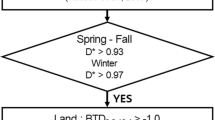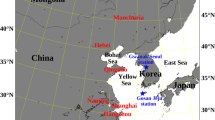Abstract
The present study deals with the use of Moderate Resolution Imaging Spectroradiometer (MODIS) thermal infrared bands in the dust detection. Eight dust storm cases over the Arabian Sea have been selected (four TERRA and four AQUA) during the year 2002–2008. The brightness temperature (BT) difference method has been applied on MODIS thermal bands 29 (8 µm), 31 (11 µm) and 32 (12 µm) to detect dust storms over the Arabian Sea. The performance assessment of BT differences (BT29–BT31 and BT31–BT32) has shown that BT31–BT32 has performed better to BT29–BT31. We suggest that BT31–BT32 is an effective combination of MODIS bands for dust detection over oceans and sea. The maximum (Dmax) and minimum dust (Dmin) intensity locations have also been identified in all the eight dust storm cases. The aerosol properties (aerosol optical thickness, τ; asymmetry factor g and Angstrom exponent α) over Dmax and Dmin have been studied using MODIS Level 2 data. In AQUA dust storms cases τ values (Dmax) were higher than TERRA dust cases, whereas g values were nearly same. The α was always positive in case of TERRA dust cases; however in AQUA negative α was also reported. Afternoon dust storms are more intense compared to forenoon dust storms and dust particles are also coarser.







Similar content being viewed by others
References
Ackerman SA (1989) Using the radiative temperature difference at 3.7 and 11 μm to tract dust outbreaks. Remote Sens Environ 27(2):129–133
Ackerman SA (1997) Remote sensing aerosols using satellite infrared observations. J Geophys Res Atmos 102(D14):17069–17079
Al-Maamary HilalMS, Hussein AK, Miqdam TC (2017) Climate change: the game changer in the Gulf Cooperation Council region. Renew Sustain Energy Rev 76:555–576
Babu SS, Moorthy KK, Satheesh SK (2004) Aerosol black carbon over Arabian Sea during intermonsoon and summer monsoon seasons. Geophys Res Lett 31(6):1–5
Baddock MC, Bullard JE, Bryant RG (2009) Dust source identification using MODIS: a comparison of techniques applied to the Lake Eyre Basin, Australia. Remote Sens Environ 113(7):1511–1528
Barcelona Dust Forecast Center (2015) Activity Report 2015. https://dust.aemet.es/about-us/report-2015. Accessed 12 May 2017
Betzer PR, Carder KL, Duce RA, Merrill JT, Tindale NW, Uematsu M, Costello DK, Young RW, Feely RA, Breland JA, Bernstein RE (1988) Long–range transport of giant mineral aerosol particles. Nature 336:568–571
Butt MJ, Assiri ME, Ali MA (2017) Assessment of AOD variability over Saudi Arabia using MODIS Deep Blue products. Environ Pollut 231:143–153
Chen YS, Sheen PC, Chen ER, Liu YK, Wu TN, Yang CY (2004) Effects of Asian dust storm events on daily mortality in Taipei, Taiwan. Environ Res 95(2):151–155. https://doi.org/10.1016/j.envres.2003.08.008
Chou MD, Chan PK, Wang M (2002) Aerosol radiative forcing derived from SeaWiFS-retrieved aerosol optical properties. J Atmos Sci 59(3):748–757
Christopher SA, Jones TA (2010) Satellite and surface-based remote sensing of Saharan dust aerosols. Remote Sens Environ 114(5):1002–1007
Coale KH, Johnson KS, Fitzwater SE, Gordon RM, Tanner S, Chavez FP, Ferioli L, Sakamoto C, Rogers P, Millero F, Steinberg P (1996) A massive phytoplankton bloom induced by an ecosystem-scale iron fertilization experiment in the equatorial Pacific Ocean. Nature 383(6600):495–501
Duan SB, Li ZL, Cheng J, Leng P (2017) Cross-satellite comparison of operational land surface temperature products derived from MODIS and ASTER data over bare soil surfaces. ISPRS J Photogramm Remote Sens 126:1–10
Jafari R, Malekian M (2015) Comparison and evaluation of dust detection algorithms using MODIS Aqua/Terra Level 1B data and MODIS/OMI dust products in the Middle East. Int J Remote Sens 36(2):597–617. https://doi.org/10.1080/01431161.2014.999880
Janugani S, Jayaram V, Cabrera SD, Rosiles JG, Gill TE, Rivera NR (2009) Directional analysis and filtering for dust storm detection in NOAA-AVHRR imagery. In: Algorithms and Technologies for multispectral, hyperspectral, and ultraspectral imagery XV 2009 Apr 27 (vol 7334, p 73341G). International Society for Optics and Photonics
Kaiser J (2005) Mounting evidence indicts fine-particle pollution. Science 307:1858–1861. https://doi.org/10.1126/science.307.5717.1858a
Karimi N, Moridnejad A, Golian S, Vali Samani JM, Karimi D, Javadi S (2012) Comparison of dust source identification techniques over land in the Middle East region using MODIS data. Can J Remote Sens 38(5):586–599. https://doi.org/10.5589/m12-048
Karimi S, Niksokhan MH, Karimi S (2016) Modeling snow cover area and predicting its changes in Haraz catchment. Imaging 2(4):450–455
Kaskaoutis DG, Badarinath KV, Kumar Kharol S, Rani Sharma A, Kambezidis HD (2009) Variations in the aerosol optical properties and types over the tropical urban site of Hyderabad, India. J Geophys Res Atmos 114(D22):1–20
Kiran VR, Talukdar S, Ratnam MV, Jayaraman A (2018) Long-term observations of black carbon aerosol over a rural location in southern peninsular India: role of dynamics and meteorology. Atmos Environ. https://doi.org/10.1016/j.atmosenv.2018.06.020
Kolla V, Biscaye PE (1977) Distribution and origin of quartz in the sediments of the Indian Ocean. J Sediment Res 47(2):642–649
Krishnamurthy V, Kinter JL (2003) The Indian monsoon and its relation to global climate variability. global climate. Springer, Berlin, pp 186–236
Kurosaki Y, Shinoda M, Mikami M (2011) What caused a recent increase in dust outbreaks over East Asia? Geophys Res Lett. https://doi.org/10.1029/2011gl047494
LADSWEB via https://ladsweb.modaps.eosdis.nasa.gov. Accessed 12 June 2016
Lee YC, Yang X, Wenig M (2010) Transport of dusts from East Asian and non-East Asian sources to Hong Kong during dust storm related events 1996–2007. Atmos Environ 44(30):3728–3738. https://doi.org/10.1016/j.atmosenv.2010.03.034
Lee SS, Lee EH, Sohn BJ, Lee HC, Cho JH, Ryoo SB (2017) Improved dust forecast by assimilating MODIS IR-based nighttime AOT in the ADAM2 model. SOLA 13:192–198
Legrand M, Plana-Fattori A, N’doumé C (2001) Satellite detection of dust using the IR imagery of Meteosat: 1. Infrared difference dust index. J Geophys Res Atmos 106(16):18251–18274
Levy RC, Remer LA, Tanré́ D, Mattoo S, Kaufman YJ (2009) Algorithm for remote sensing of tropospheric aerosol over dark targets from MODIS: collections 005 and 051: Revision 2; Feb 2009. MODIS algorithm theoretical basis document
Li X, Song W (2009) Dust storm detection based on Modis data. In: International conference on geo-spatial solutions for emergency management and the 50th anniversary of the Chinese Academy of surveying and mapping 169–172
MCTK via https://github.com/dawhite/MCTK. Accessed 12 Jan 2017
Martin JH, Coale KH, Johnson KS, Fitzwater SE, Gordon RM, Tanner SJ, Hunter CN, Elrod VA, Nowicki JL, Coley TL, Barber RT (1994) Testing the iron hypothesis in ecosystems of the equatorial Pacific Ocean. Nature 371(6493):123–129
Middleton NJ (1986) A geography of dust storms in South-west Asia. Int J Climatol 6(2):183–196
Moorthy KK, Babu SS, Satheesh SK (2005) Aerosol characteristics and radiative impacts over the Arabian Sea during the intermonsoon season: results from ARMEX field campaign. J Atmos Sci 62(1):192–206
Munir MM, Sasmito B, Haniah H (2015) Analisis Pola Kekeringan Lahan Pertanian Di Kabupaten Kendal Dengan Menggunakan Algoritma Thermal Vegetation Index Dari Citra Satelit Modis Terra. J Geodesi Undip 4(4):174–180
Norton CC, Mosher FR, Hinton B, Martin DW, Santek D, Kuhlow W (1980) A model for calculating desert aerosol turbidity over the oceans from geostationary satellite data. J Appl Meteorol 19(6):633–644
Operational Dust Storm Forecasting at the Met Office. Available via http://forecast.uoa.gr/Dust-wshop-pdf/Brooks.pdf. Accessed 23 Oct 2017
Pease PP, Tchakerian VP, Tindale NW (1998) Aerosols over the Arabian Sea: geochemistry and source areas for aeolian desert dust. J Arid Environ 39(3):477–496
Reed L, Nugent K (2018) The health effects of dust storms in the Southwest United States. Southwest Respir Crit Care Chronicles 6(22):42–46
Sateesh M, Soni VK, Raju PVS (2018) Effect of diwali firecrackers on air quality and aerosol optical properties over mega city (Delhi) in India. Earth Syst Environ. https://doi.org/10.1007/s41748-018-0054-x
Satheesh SK, Moorthy KK (1998) Aerosol characteristics over coastal regions of the Arabian Sea. Oceanogr Lit Rev 3(45):466
Satheesh SK, Moorthy KK, Kaufman YJ, Takemura T (2006) Aerosol optical depth, physical properties and radiative forcing over the Arabian Sea. Meteorol Atmos Phys 91(1–4):45–62
Shao Y (2008) Physics and modelling of wind erosion, vol 37. Springer, Berlin
Shenk WE, Curran RJ (1974) The detection of dust storms over land and water with satellite visible and infrared measurements. Mon Weather Rev 102(12):830–837
Shi GY, Zhao SX (2003) Several scientific issues of studies on the dust storms Chin. J Atmos Sci 27(4):591–606
Singh J (2016) Ranking South African provinces on the basis of MERRA 2D surface incident shortwave flux. J Energy South Afr 27(3):50–57
Sirocko F (1991) Deep-sea sediments of the Arabian Sea: a paleoclimatic record of the southwest-Asian summer monsoon. Geol Rundsch 80(3):557–566
Solmon F, Nair VS, Mallet M (2015) Increasing Arabian dust activity and the Indian summer monsoon. Atmos Chem Phys 15(14):8051–8064
Stocker TF et al (2013) Contribution of Working Group I to the fifth assessment report of the intergovernmental panel on climate change climate change 2013: the physical science basis. Cambridge University Press, Cambridge
Taghavia F, Mohammadi H (2008) The survey of linkage between climate changes and desertification using extreme climate index software. Desert 13(1):9–17
Vincent RF (2018) The effect of Arctic dust on the retrieval of satellite derived sea and ice surface temperatures. Sci Rep 8(1):9727
Wang T, Yan CZ, Song X, Li S (2013) Landsat images reveal trends in the aeolian desertification in a source area for sand and dust storms in China’s Alashan plateau (1975–2007). Land Degrad Dev 24(5):422–429
Washington R, Todd M, Middleton NJ, Goudie AS (2003) Dust-storm source areas determined by the total ozone monitoring spectrometer and surface observations. Ann Assoc Am Geogr 93(2):297–313
Xie Y, Zhang W, Qu JJ (2017) Detection of Asian dust storm using MODIS measurements. Remote Sens 9(8):869
Yu M, Yang C (2016) Improving the non-hydrostatic numerical dust model by integrating soil moisture and greenness vegetation fraction data with different spatiotemporal resolutions. PLoS ONE 11(12):e0165616
Yue H, He C, Zhao Y, Ma Q, Zhang Q (2017) The brightness temperature adjusted dust index: an improved approach to detect dust storms using MODIS imagery. Int J Appl Earth Obs Geoinf 57:166–176
Zhang P, Lu NM, Hu XQ, Dong CH (2006) Identification and physical retrieval of dust storm using three MODIS thermal IR channels. Glob Planet Change 52(1–4):197–206
Zhang B, Tsunekawa A, Tsubo M (2008) Contributions of sandy lands and stony deserts to long-distance dust emission in China and Mongolia during 2000–2006. Glob Planet Change 60(3–4):487–504
Zhu A, Ramanathan V, Li F, Kim D (2007) Dust plumes over the Pacific, Indian, and Atlantic oceans: climatology and radiative impact. J Geophys Res: Atmospheres 112(D16):1–20
Acknowledgements
We would like to acknowledge the Indian Institute of Remote Sensing Dehradun for conducting this research work. We express our thanks to Department of Meteorology, Stockholm University for support during the project. We also want to acknowledge NASA for MODIS data.
Author information
Authors and Affiliations
Corresponding author
Ethics declarations
Conflict of interest
The authors state that there is no conflict of interest. The authors also declare that there is no financial or personal relationship with a third party whose interests could be positively or negatively influenced by this article’s content.
Rights and permissions
About this article
Cite this article
Singh, J., Noh, YJ., Agrawal, S. et al. Dust Detection and Aerosol Properties Over Arabian Sea Using MODIS Data. Earth Syst Environ 3, 139–152 (2019). https://doi.org/10.1007/s41748-018-0079-1
Received:
Accepted:
Published:
Issue Date:
DOI: https://doi.org/10.1007/s41748-018-0079-1




